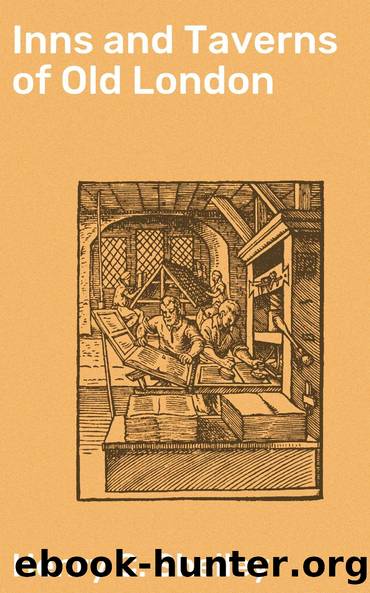Inns and Taverns of Old London by Henry C. Shelley

Author:Henry C. Shelley [Shelley, Henry C.]
Language: eng
Format: epub
ISBN: 9781533234353
Google: 1yS3DAEACAAJ
Publisher: CreateSpace Independent Publishing Platform
Published: 2016-05-13T00:52:48+00:00
CHAPTER II.
Table of Contents
ROUND ST. PAUL'S.
If there was a certain incongruity in the physicians having their special coffee-house in the heart of the city, there was none in clerics affecting the St. Paul's coffee-house under the shadow of the cathedral of that name. This being the chief church of the metropolis, notwithstanding the greater historic importance of Westminster Abbey, it naturally became the religious centre of London so far as clergymen were concerned. But the frequenters of this house were of a mixed type. That historian of Batson's who was quoted in the previous chapter, related that after leaving its dismal vicinity he was glad to "breathe the pure air in St. Paul's coffee-house," but he was obliged to add that as he entertained the highest veneration for the clergy he could not "contemplate the magnificence of the cathedral without reflecting on the abject condition of those 'tatter'd crapes,' who are said to ply here for an occasional burial or sermon, with the same regularity as the happier drudges who salute us with the cry of 'coach, sir,' or 'chair, your honour.'" Somewhat late in the eighteenth century St. Paul's coffee-house had a distinguished visitor in the person of Benjamin Franklin, who here made the acquaintance of Richard Price, that philosophical dissenting divine whose pamphlet on American affairs is said to have had no inconsiderable part in determining Americans to declare their independence. The fact that Dr. Price frequented the St. Paul's coffee-house is sufficient proof that its clients were not restricted to clergymen of the established church.
More miscellaneous was the patronage of Child's, another resort in St. Paul's Church-yard. It is sometimes described as having been a clerical house like the St. Paul's, and one reference in the Spectator gives some support to that view. The writer told how a friend of his from the country had expressed astonishment at seeing London so crowded with doctors of divinity, necessitating the explanation that not all the persons in scarfs were of that dignity, for, this authority on London life continued, "a young divine, after his first degree in the university, usually comes hither only to show himself; and on that occasion, is apt to think he is but half equipped with a gown and cassock for his public appearance, if he hath not the additional ornament of a scarf of the first magnitude to entitle him to the appellation of Doctor from his landlady and the boy at' Child's." There is another allusion to the house in the Spectator. "Sometimes I"âthe writer is Addisonâ"smoke a pipe at Child's, and while I seem attentive to nothing but the Postman, overhear the conversation of every table in the room." Apart from such decided lay patrons as Addison, Child's could also claim a large constituency among the medical and learned men of the day.
Notwithstanding its ecclesiastical name, the Chapter coffee-house in Paul's Alley was not a clerical resort. By the middle of the eighteenth century it had come to be recognized as the rendezvous of publishers and booksellers.
Download
This site does not store any files on its server. We only index and link to content provided by other sites. Please contact the content providers to delete copyright contents if any and email us, we'll remove relevant links or contents immediately.
The Memoirs of Pere Labat, 1693-1705 by Jean Baptiste(175)
Water by John Boyne(136)
The Memoirs of Count Grammont â Complete by Hamilton Anthony Count Walter Scott(111)
Famous Fights of Indian Native Regiments by Reginald Hodder(105)
A History of the Peninsular War, Vol. 5, Oct. 1811-Aug. 31, 1812 by Charles Oman(99)
1916 - The Battle of the Five Empires: 15 May - 28 September 1916 by Benoît Chenu(95)
Maleficium: Witchcraft and Witch Hunting in the West by Gordon Napier(91)
Life of Napoleon Bonaparte, Volume I. by Walter Scott(87)
Evolution Of The Japanese, Social And Psychic by Sidney Lewis Gulick(86)
The Apollo Moon Missions by Randy Walsh(83)
Famous Reviews, Selected and Edited with Introductory Notes by R. Brimley Johnson by Various R. Brimley Johnson(81)
Joanna of Flanders by Julie Sarpy(76)
Memoir of the Life and Services of Vice-Admiral Sir Jahleel Brenton, Baronet, K.C.B by Various Henry Raikes(73)
Fry The Brain: The Art of Urban Sniping and its Role in Modern Guerrilla Warfare by John West(73)
Inns and Taverns of Old London by Henry C. Shelley(70)
Elizabethan Demonology by Thomas Alfred Spalding(68)
Rasputin the Rascal Monk by William Le Queux(66)
History of the Revolt of the Netherlands â Complete by Friedrich Schiller(65)
A Winter Tour in South Africa by Frederick Young(63)
